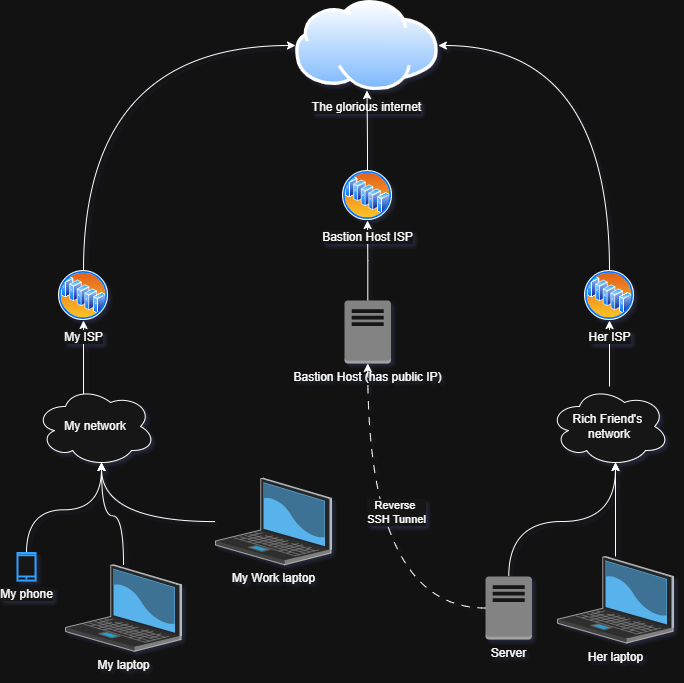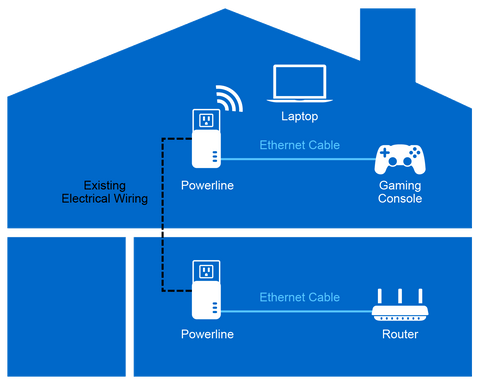Setting up a home server network might sound complicated, but it doesn’t have to be. Imagine having all your files, media, and important data available anytime, anywhere in your home.
You can stream movies, back up your devices, and even run your own websites—all from one central hub. If you’ve ever felt frustrated by scattered files or slow transfers, this setup will change the way you manage your digital life.
Keep reading, and you’ll discover simple steps to create a home server network that works perfectly for you.
Choosing The Right Hardware
Setting up a home server needs careful hardware choices. The right parts make the server fast and reliable.
You need to think about the server type, network gear, and storage. These help your server work well every day.
Server Types And Specifications
Pick a server type based on what you want to do. Different servers fit different jobs like media streaming or file storage.
Look at the CPU, RAM, and power use. A fast CPU helps with many tasks. More RAM keeps things running smooth.
- Mini PCs are small and use less power
- Towers offer better upgrades and cooling
- Rack servers fit in tight spaces and scale well
- Use at least 8GB RAM for good multitasking
- Choose a CPU with multiple cores for speed
Networking Equipment Essentials
Good networking gear is key for fast data transfer. Your server needs a strong connection to your home network.
Use a reliable router and a wired connection if you can. Wired connections are faster and more stable than Wi-Fi.
- Gigabit Ethernet switches for fast data flow
- Cat6 or higher Ethernet cables for better speed
- Wireless access points to extend Wi-Fi range
- Uninterruptible power supply (UPS) to protect gear
Storage Options And Considerations
Storage is where your data lives. Choose drives based on speed, size, and cost.
Combine different storage types for best results. Use fast SSDs for the system and big HDDs for files.
| Storage Type | Speed | Capacity | Cost |
|---|---|---|---|
| SSD | Fast | Low to Medium | Higher |
| HDD | Slower | High | Lower |
| NAS Drives | Moderate | High | Medium |
- Use RAID for data protection
- Regular backups keep data safe
- Consider storage expansion options
Setting Up Your Network
Setting up a home server network helps you share files and resources easily. It also improves security and control over your devices.
This guide explains how to set up your network with clear steps. You will learn about wired and wireless connections, router and switch settings, and static IP addresses.
Wired Vs Wireless Connections
Wired connections use cables to link devices directly. They offer fast and stable connections with low delay.
Wireless connections use Wi-Fi to connect devices without cables. They provide more freedom but may have slower speeds and interference.
- Wired: faster and more reliable
- Wireless: flexible and easy to set up
- Wired is best for servers needing steady speed
- Wireless suits mobile devices and casual use
Configuring Routers And Switches
Routers connect your home network to the internet. Switches connect multiple devices within your network.
To set up your network, log in to your router’s settings. You can change Wi-Fi names, passwords, and security options there.
- Assign different Wi-Fi names for 2.4 GHz and 5 GHz
- Use WPA3 or WPA2 for better security
- Connect switches to expand wired device connections
- Keep router firmware updated for best performance
Assigning Static Ip Addresses
Static IP addresses stay the same for a device. They help servers and printers stay easy to find on your network.
Assign static IPs in your router’s DHCP settings or directly on the device. Make sure the IP is outside the router’s automatic range.
- Pick an IP outside the DHCP pool to avoid conflicts
- Use static IPs for devices needing constant access
- Record assigned IPs to manage your network better
- Restart devices after setting static IPs to apply changes
Optimizing For Speed
Setting up a home server network requires careful planning. Speed is a key factor to ensure smooth data transfer.
Fast networks reduce waiting time and improve your experience using the server.
Using Gigabit Ethernet
Gigabit Ethernet offers speeds up to 1,000 Mbps. It is much faster than older Ethernet types.
Using Gigabit Ethernet cables and switches helps your server send and receive data quickly.
- Use Cat5e or higher cables for Gigabit support
- Check that all devices support Gigabit Ethernet
- Replace old routers or switches with Gigabit models
Network Bandwidth Management
Bandwidth management controls how much data each device can use. This avoids slowdowns.
It helps keep your network fast, even when many devices connect at once.
- Limit bandwidth for non-essential devices
- Monitor data usage to find heavy users
- Use software tools to set bandwidth limits
Quality Of Service Settings
Quality of Service (QoS) lets you prioritize important traffic. This keeps critical tasks running smoothly.
QoS is useful for streaming, gaming, or video calls on your home server.
- Assign high priority to server traffic
- Lower priority for background updates and downloads
- Use your router’s QoS settings to manage traffic
Securing Your Home Server
A home server stores important data and runs many tasks. Keeping it safe protects your files and privacy.
Security helps stop hackers and keeps your network strong. Use simple steps to protect your server at home.
Firewall Configuration
A firewall controls traffic to and from your server. It blocks unwanted access and allows safe connections.
Set up rules to allow only trusted devices and services. This reduces the chance of attacks on your home server.
- Block all unused ports
- Allow traffic only from known IP addresses
- Use stateful packet inspection
- Log firewall activity for review
Implementing Vpn Access
A VPN creates a secure tunnel to your home server. It protects your data when you connect remotely.
Use VPN software on your server and devices. This keeps your connection private and hides your IP address.
- Choose a reliable VPN protocol like OpenVPN
- Set strong passwords for VPN accounts
- Limit VPN access to needed users only
- Regularly check VPN logs for unusual activity
Regular Software Updates
Updating software fixes security weaknesses. It protects your server from new threats and bugs.
Check for updates often and install them quickly. This includes your server OS, apps, and security tools.
- Enable automatic updates if possible
- Backup data before major updates
- Monitor update release notes for security fixes
- Test updates on a non-critical system first
Remote Access And Management
Setting up remote access allows you to control your home server from anywhere. It makes managing files and settings easy and fast.
Remote management helps keep your server updated and secure without needing to be near it physically.
Setting Up Remote Desktop
Remote desktop lets you see and use your home server screen on another device. You can work as if you are in front of the server.
To set this up, enable remote desktop on your server and use a client app on your computer or tablet.
- Enable Remote Desktop in system settings
- Use apps like Microsoft Remote Desktop or VNC Viewer
- Ensure your server firewall allows remote desktop connections
- Use strong passwords for security
Using Secure Shell (ssh)
SSH lets you control your server using a command line interface. It is fast and secure for managing files and running commands.
To use SSH, install an SSH server on your home server and connect with an SSH client from your device.
- Install OpenSSH server on your home server
- Use clients like PuTTY or Terminal to connect
- Use key-based authentication for better security
- Change default ports to reduce attack risks
Mobile Access Solutions
Mobile access lets you control your server from smartphones or tablets. It is useful when you are away from your computer.
Use apps designed for remote desktop or SSH to connect to your home server safely on mobile devices.
- Install remote desktop apps like Microsoft Remote Desktop
- Use SSH apps such as Termius or JuiceSSH
- Ensure mobile devices connect over secure Wi-Fi or VPN
- Keep apps and server software up to date

Credit: www.reddit.com
Backup And Data Protection
Setting up a home server requires strong backup plans. Data protection keeps your files safe from loss.
Good backup methods save time and prevent stress. They help you recover files after accidents.
Automated Backup Strategies
Automated backups run on a set schedule. They copy files without you needing to start them.
Use software to set daily or weekly backups. This keeps your data current and safe.
- Full backups save all data each time
- Incremental backups save only new files
- Differential backups save changes since last full backup
Redundancy And Raid Options
Redundancy means keeping extra copies of data. It helps if one disk fails.
RAID uses multiple hard drives to protect data. It can increase speed or safety.
- RAID 1 mirrors data on two drives
- RAID 5 spreads data with parity for fault tolerance
- RAID 10 combines mirroring and striping
Disaster Recovery Planning
Disaster recovery plans prepare you for data loss events. They guide you to restore data fast.
Test your backup and recovery process. Make sure you can restore files if needed.
- Keep backups offsite or in the cloud
- Document recovery steps clearly
- Check backups regularly for errors
Common Troubleshooting Tips
Setting up a home server network can sometimes cause problems. Knowing how to fix common issues helps keep your server running well.
This guide covers simple tips for solving network problems, checking server performance, and dealing with security issues.
Diagnosing Network Issues
Start by checking if all cables are connected properly. Loose or damaged cables can cause network failures.
Use tools like ping and traceroute to find where the connection is failing. This shows if the problem is local or remote.
- Restart your router and server to clear temporary errors
- Check IP addresses to avoid conflicts
- Verify firewall settings that might block traffic
- Update network drivers on your server
Server Performance Monitoring
Watch your server’s CPU, memory, and disk use to spot performance problems early. High use may slow your server down.
Set up alerts to know when resources reach critical levels. This helps you act before issues affect users.
- Use built-in tools like Task Manager or top command
- Install monitoring apps for detailed reports
- Check running services and stop unused ones
- Schedule regular maintenance and updates
Handling Security Breaches
Security breaches can harm your server and data. Act fast to limit damage if you detect a breach.
Change all passwords and check logs to find how the breach happened. Remove any suspicious files or users.
- Keep your server software up to date
- Use strong, unique passwords for all accounts
- Enable firewalls and antivirus software
- Back up your data regularly and store it safely

Credit: ritiktaneja.medium.com

Credit: www.reddit.com
Frequently Asked Questions
What Equipment Is Essential For A Home Server Network Setup?
A home server network needs a reliable router, server hardware, and Ethernet cables. Optional devices include switches, NAS, and UPS for power backup. Proper equipment ensures stable connections and efficient data handling.
How Do I Secure My Home Server Network?
Secure your home server by using strong passwords, enabling firewalls, and regularly updating software. Use VPNs and disable unused services to prevent unauthorized access. Regular backups also enhance data safety.
Can I Use A Raspberry Pi As A Home Server?
Yes, Raspberry Pi is affordable and energy-efficient for light home server tasks. It supports media streaming, file sharing, and home automation. However, it’s less powerful than dedicated servers for heavy workloads.
What Are The Benefits Of A Wired Vs Wireless Home Server Connection?
Wired connections offer faster speeds, lower latency, and better reliability than wireless. Wireless provides convenience and flexibility but can suffer interference and slower speeds. Choose based on your speed needs and setup location.
Conclusion
Setting up a home server network can be simple and rewarding. Start by understanding your needs. Choose hardware and software that fits your requirements. Organize your cables and connections neatly. Regularly update and secure your system. This ensures smooth and safe operation.
Troubleshooting becomes easier with this groundwork. Enjoy the flexibility and control over your data. A personalized network supports your digital lifestyle. Plus, it can save money in the long run. With patience and practice, anyone can set up a home server network.
Explore, learn, and enjoy the benefits today.
20 min read








